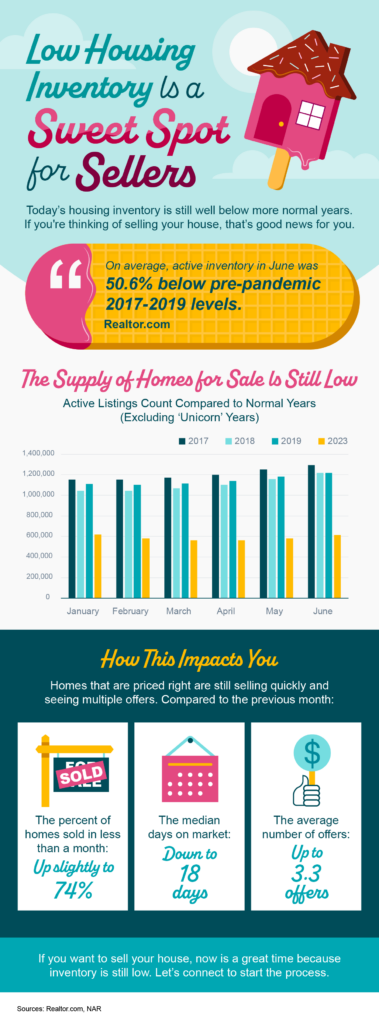
In the dynamic world of real estate, market conditions often shift, presenting unique opportunities for both buyers and sellers. Currently, one such advantageous situation is the low housing inventory, which creates a sweet spot for sellers. In this blog post, we’ll explore the reasons why a low housing inventory can work to a seller’s advantage, highlighting the benefits and strategies for maximizing returns in such a market.
- Increased Demand: When housing inventory is low, the demand for available homes tends to be high. Buyers, motivated by the scarcity of options, may find themselves in a competitive environment, resulting in bidding wars and potentially driving up prices. As a seller, this increased demand puts you in a favorable position to attract multiple offers and secure a higher selling price.
- Faster Sales: In a low inventory market, homes often sell at a quicker pace. Buyers have fewer options to choose from, and if your property meets their criteria, they are more likely to make prompt decisions. This shorter time on the market benefits sellers by reducing carrying costs, such as mortgage payments, utilities, and maintenance expenses, allowing them to move on to their next venture more swiftly.
- Favorable Negotiation Power: With limited housing options available, sellers gain a stronger position during negotiations. Buyers may be more willing to compromise on certain terms or pay a higher price to secure a desirable property. As a seller, you can leverage this advantage to negotiate favorable terms, such as a faster closing timeline or fewer contingencies, enhancing the overall selling experience.
- Increased Equity: A low housing inventory can be especially beneficial for homeowners who have built substantial equity in their properties. The high demand and potential bidding wars can drive up prices, resulting in a higher selling price than anticipated. This boost in equity allows sellers to reap greater financial rewards, potentially using the proceeds for future investments or to upgrade to a more desirable property.
- Strategic Pricing: In a low inventory market, pricing your home strategically becomes crucial. Consulting with a knowledgeable real estate agent can help you determine the optimal listing price based on recent comparable sales, market conditions, and buyer demand. Setting the right price from the start can attract motivated buyers, creating a sense of urgency and generating multiple offers.
- Marketing Advantage: With fewer homes available, your property stands out more prominently in the market. By employing effective marketing strategies, such as professional photography, staging, and online listing optimization, you can maximize your property’s appeal and generate greater interest among potential buyers. Additionally, showcasing unique features and highlighting the scarcity of comparable options can make your home even more enticing
BOTTOM LINE
Low housing inventory presents an opportune time for sellers to capitalize on the market conditions. The increased demand, faster sales, negotiation power, equity growth, strategic pricing, and marketing advantages all align to create a sweet spot for sellers. If you are considering selling your home, seize this advantageous moment, work with experienced professionals, and make the most of the low housing inventory environment. Let’s connect today!





